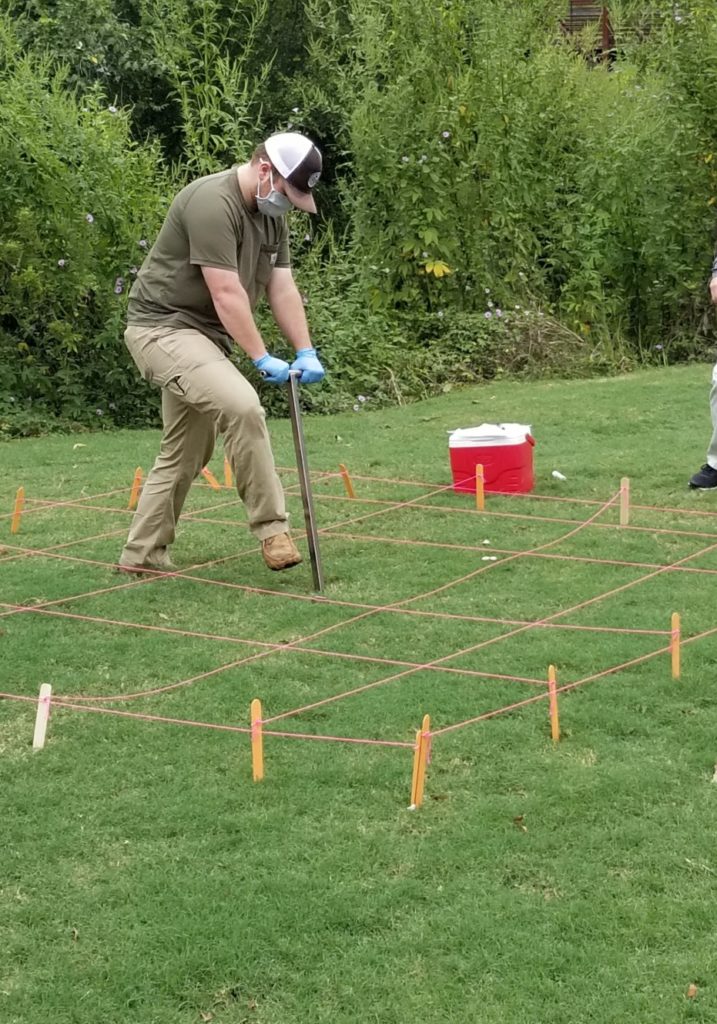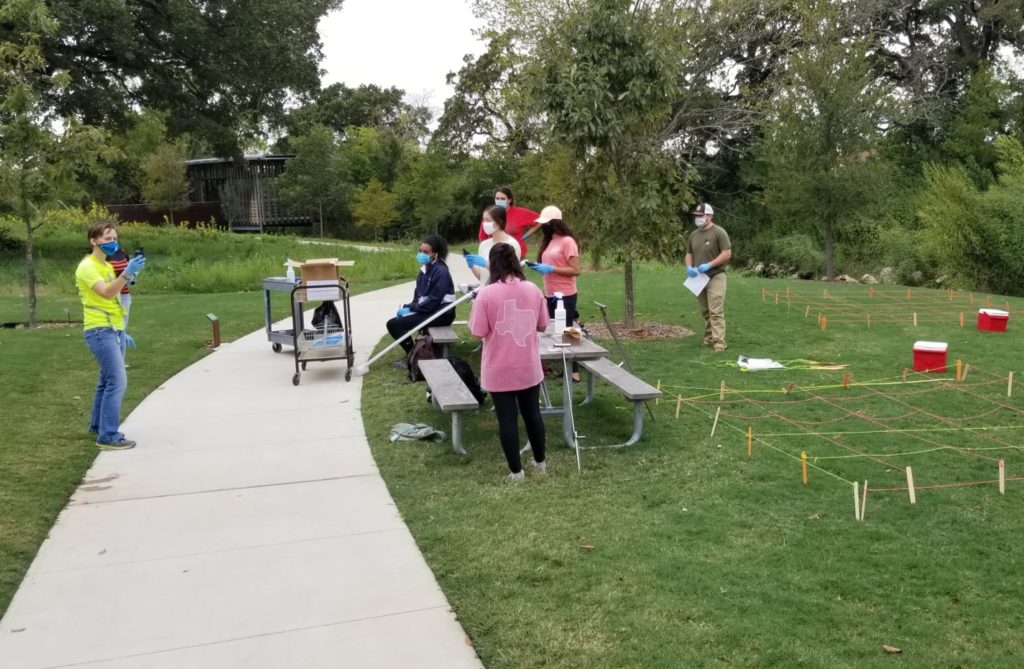Sampling a new classroom environment to stay engaged during COVID-19
Students receive hands-on experience in environmental sampling using The Gardens
When the COVID-19 pandemic struck, faculty members across the Texas A&M University System were challenged to find ways to keep their students engaged, while teaching remotely during last spring and fall semesters. For some, that meant thinking outside the conventional classroom and creating a new environment for students to learn safely.
As part of her remote teaching, instructional associate professor Kati Stoddard, Ph.D., in the Department of Plant Pathology and Microbiology in the College of Agriculture and Life Sciences used The Gardens at Texas A&M University in Bryan-College Station as the site for her Introduction to Bioenvironmental Sciences and Sampling and Environmental Monitoring courses during the 2020 academic year.
Sampling Days provide real-world experiences
Last fall, Stoddard created a series of outdoor learning activities she called “Sampling Days” to help demonstrate how to collect various types of environmental samples.
During Sampling Days, Stoddard used The Gardens, a 27-acre public teaching garden located on campus, to help teach sampling and monitoring techniques in her bioenvironmental sciences course offered to junior and senior students.

Stoddard divided her students in small, socially distanced groups of four to seven students, then they went into The Gardens to conduct surface water, groundwater and soil sampling.
“I love using The Gardens because it facilitates real-world experiences for the students in a beautiful and convenient location,” Stoddard said. “The Sampling Days were the highlight of the semester for many of my students because they were able to get outside and away from their computers where most of the classes were being taught.”
She also brought in industry experts to demonstrate the installation of a demonstration groundwater monitoring well.
Stoddard said these activities expanded students’ knowledge of course concepts by allowing them to get hands-on experience with the equipment and challenging them to demonstrate mastery of the techniques learned in lecture.
Innovative teaching in a pandemic
Stoddard said the challenge of teaching in the pandemic was the virtual nature of teaching via videoconferencing, but she said that the technology tools she used were very helpful.
“Aside from the Sampling Days, all my class sessions in the fall were online, either synchronously or asynchronously,” she said. “Engaging the students in online synchronous classes is challenging, but using Zoom, Poll Everywhere and Google tools really helped to keep the students engaged.”
To help keep students in the synchronous sessions engaged, Stoddard used the Poll Everywhere polling software in the sampling class to keep track of whether students were understanding the material and concepts taught throughout each online synchronous lesson. Poll Everywhere is a web- and mobile device-based polling application that helps instructors have more engaging lectures. Instructors may use it for either attendance or assessing understanding of concepts in a lecture.
“I start the class with an open-ended question designed to check in on students’ well-being and their stress management and to help students connect with each other regarding shared interests,” she said. “Then I used Poll Everywhere to ask course content specific questions throughout the lessons to gauge student’s comprehension of concepts we just discussed and see if there is any need for me to review and possibly explain those concepts in a different way.”
She also has used the tournament feature in Poll Everywhere as a fun way to test her students content knowledge using gamification, which can increase motivation and engagement with students.
Stoddard’s teaching caught the attention of the Association of Former Students of Texas A&M as they recently presented her the Association’s Distinguished Achievement Award for College Level Teaching for her efforts in continuing teaching during the pandemic.
A passion for teaching
Stoddard’s passion for the environment began at a young age, and she started discovering her passion for teaching in graduate school.
“I’m excited to teach students about the environment because I think we can all do our part to maintain a safe and healthy environment,” she said. “As I educate students about the environment, I encourage and teach them to think critically about the topics we study. I also guide students to consider their own impact and how they can make small, positive changes for the health of the planet and those who call it home.”
Stoddard is a former student who earned her undergraduate degree in bioenvironmental sciences, which she said makes teaching in this degree program that much more rewarding. She earned her master’s degree in water management and hydrological science program at Texas A&M and her doctorate in environmental science from the University of North Texas.
“I feel privileged to teach Texas A&M students, and I love that I get to teach students earning the same degree that I earned,” she said. “I am excited to help all of my students prepare for their professional careers and to be a resource to those working through the bioenvironmental sciences.”
Stoddard also teaches the Introduction to Bioenvironmental Sciences course, which she said is her way of teaching students how to help preserve the planet for future generations.
“It’s deeply rewarding when students tell me that I’ve helped them see the world in a new way, helped them realize something fundamental about themselves or helped them identify what they want to do after college,” Stoddard said.
Senior bioenvironmental sciences major Bryce Green has taken both courses Stoddard teaches.
Green said Stoddard went above and beyond to accommodate their class and provide impactful learning experiences in a new environment, despite the challenges that COVID-19 presented.
“The thing that stands out to me is the way that Dr. Stoddard cares about her students, especially in a global pandemic,“ he said. “She sacrificed her time for us to get sampling experience that correlated directly to the class.”



